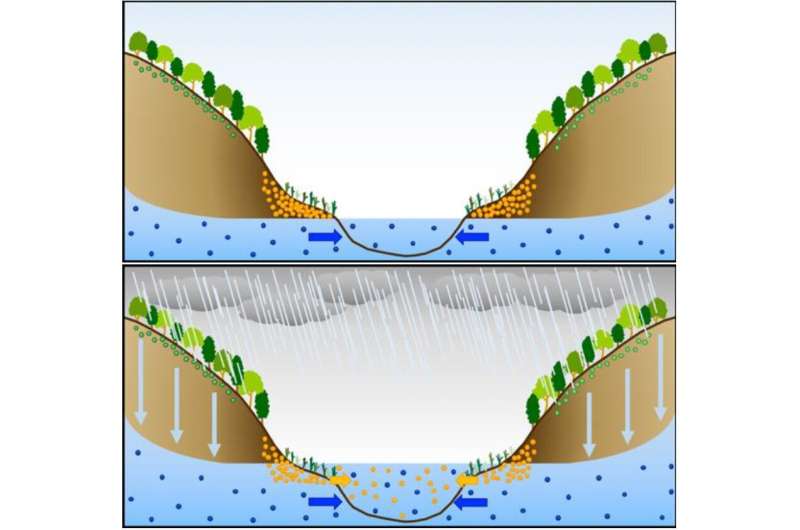Soil along streams is a bigger source of stream nitrate than rainwater

Researchers from Nagoya University in Japan have reported that nitrate accumulated in soil bordering streams plays an important role in the increase of nitrate levels in stream water when it rains. Their findings, published in the journal Biogeosciences, may help reduce nitrogen pollution and improve water quality in downstream bodies of water, such as lakes and nearshore waters.
Nitrate is an essential nutrient for plants and phytoplankton, but excessive nitrate levels in streams can damage water quality, cause eutrophication (the over-enrichment of water by nutrients), and pose health risks to animals and humans. Although it’s known that nitrate levels in streams rise when it rains, the reason for this is unclear.
There are two leading theories of how stream nitrate increases when it rains. According to the first theory, the nitrate in the atmosphere dissolves in rainwater and falls directly into streams. Whereas the second theory is that, when it rains, soil nitrate in the area that borders the stream, known as the riparian zone, flows into stream water.
To further investigate the source of the nitrate, a Nagoya University research team led by Professor Urumu Tsunogai at the Graduate School of Environmental Studies, collaborating with the Asia Center for Air Pollution Research, conducted a study to analyze changes in the isotopic compositions of nitrogen and oxygen in nitrate and the increase of nitrate concentrations in a stream during rainstorms.
Previous studies have reported that nitrate concentrations significantly increase during storms in the streams of the upper Kajikawa River in Niigata, northwestern Japan. The researchers collected water samples from the Kajikawa catchment area, comprising the streams of the upper part of the river. They used an automatic water sampler to take samples from the catchment stream water at one-hour intervals for 24 hours during three storms.
Measuring the concentrations and the isotopic compositions of nitrate in the stream water, the group next compared the results with the concentrations and the isotopic compositions of soil nitrate in the riparian zone of the stream. As a result, they found that most of the nitrate came from the soil in the zone rather than rainwater.
“We concluded that the flushing of soil nitrate in the riparian zone into the stream due to the rising of both stream water and groundwater level was primarily responsible for the increase in stream nitrate during the storm event,” said Dr. Weitian Ding of Nagoya University, the corresponding author of the study.
The research group also analyzed the impact of atmospheric nitrate on increasing stream nitrate during the storms. Regardless of an increase in precipitation, atmospheric nitrate in stream water remained constant, suggesting that the atmospheric sources of nitrate had a minimal effect.
The researchers also found that the soil nitrate in the riparian zone was produced by soil-dwelling microorganisms. “Microbe-derived nitrate is thought to be accumulated in soil in the riparian zone only in summer and autumn in Japan,” explained Professor Tsunogai. “From this perspective, we can predict that the increase of stream nitrate due to rain occurs only in these seasons.” Understanding the seasonality of nitrate increases could be an important finding to help ensure safe fresh water.
Weitian Ding et al, Tracing the source of nitrate in a forested stream showing elevated concentrations during storm events, Biogeosciences (2022). DOI: 10.5194/bg-19-3247-2022
Citation:
Soil along streams is a bigger source of stream nitrate than rainwater (2022, October 5)
retrieved 5 October 2022
from https://phys.org/news/2022-10-soil-streams-bigger-source-stream.html
This document is subject to copyright. Apart from any fair dealing for the purpose of private study or research, no
part may be reproduced without the written permission. The content is provided for information purposes only.
For all the latest Science News Click Here
For the latest news and updates, follow us on Google News.

